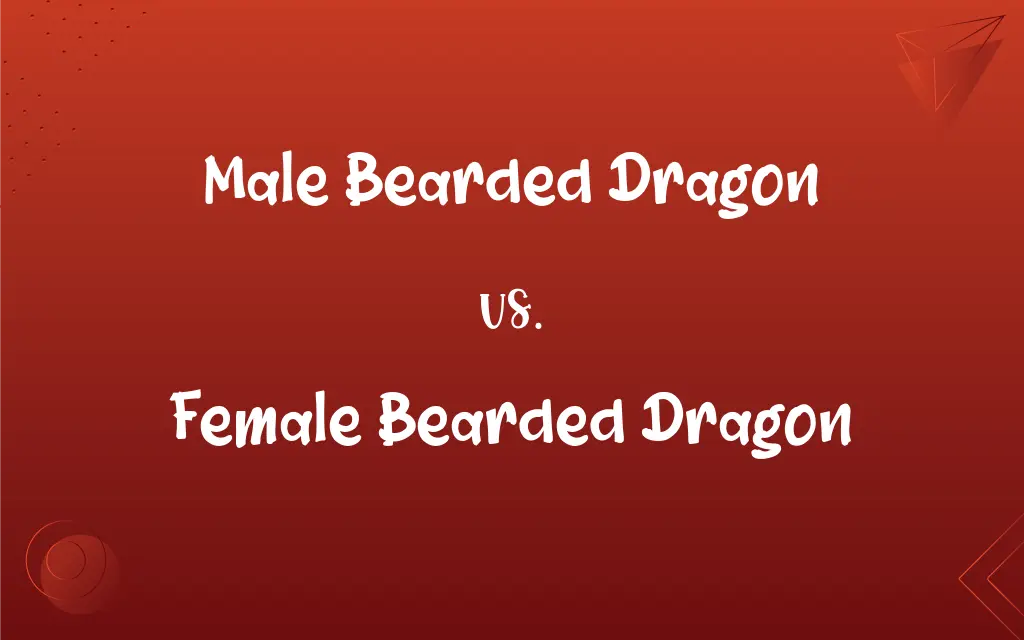Male Bearded Dragon vs. Female Bearded Dragon: What's the Difference?
Edited by Janet White || By Harlon Moss || Updated on October 29, 2023
Male bearded dragons are larger with broader heads; females lay eggs and are generally smaller. Both are popular pet lizards.

Key Differences
The male bearded dragon and the female bearded dragon are both members of the same species, Pogona vitticeps, known for their iconic "beard" of spiky scales. However, they possess distinct physical and behavioral differences. While both the male and female bearded dragons display the characteristic beard.
One of the notable physical differences between a male bearded dragon and a female bearded dragon lies in their body size and shape. Typically, male bearded dragons are larger, with broader heads and chunkier tails. Their tails often have a thicker base because of the presence of two hemipenes, which are the reproductive organs in male reptiles. In contrast, female bearded dragons tend to have a more slender and streamlined appearance, with narrower heads and slimmer tails.
Another distinguishing feature between male and female bearded dragons is found in their femoral pores. Male bearded dragons usually have larger and more pronounced femoral pores, which are situated on the underside of their thighs. These pores secrete a waxy substance, especially during the breeding season, which helps mark territory and attract females. The female bearded dragon also possesses femoral pores, but they are smaller and less conspicuous than those of their male counterparts.
Behaviorally, there are observable differences between the male and female bearded dragon, especially during mating season. Male bearded dragons often exhibit more dominant and territorial behaviors, such as head bobbing, to establish dominance and attract potential mates. They might also be seen waving one arm in a slow, circular motion as a sign of submission or recognition. Female bearded dragons, on the other hand, might respond to male displays with their own set of behaviors, such as fast arm waves, indicating submission or receptiveness.
Comparison Chart
Size and Build
Larger with broader heads.
Smaller and slender.
ADVERTISEMENT
Beard Prominence
More pronounced beards.
Less conspicuous beards.
Territorial Behavior
More territorial and aggressive.
Less territorial, except when nesting.
Reproductive Role
Do not lay eggs.
Capable of laying eggs.
Care Requirements
Standard diet and habitat.
May need extra calcium when breeding.
Male Bearded Dragon and Female Bearded Dragon Definitions
Male Bearded Dragon
Known for territorial displays and sometimes aggression.
The male bearded dragon bobbed his head rapidly to assert dominance.
ADVERTISEMENT
Female Bearded Dragon
A female of the Pogona species, recognizable by its beard-like scales.
The female bearded dragon basked under the heat lamp.
Male Bearded Dragon
A male of the species Pogona, known for its beard-like scales.
The male bearded dragon puffed up his beard to appear more intimidating.
Female Bearded Dragon
Needs a habitat with controlled temperature and UVB lighting.
She ensured the female bearded dragon's enclosure was at the right temperature.
Male Bearded Dragon
A popular pet for reptile enthusiasts.
The family chose a male bearded dragon as their first reptile pet.
Female Bearded Dragon
Generally smaller and less aggressive than the male.
Her female bearded dragon was more approachable and gentle.
Male Bearded Dragon
Often larger and more robust than its female counterpart.
His male bearded dragon grew to be quite large and imposing.
Female Bearded Dragon
Capable of laying eggs, requiring special care during this time.
The female bearded dragon prepared a nesting area to lay her eggs.
Male Bearded Dragon
Requires a controlled environment with heat and UV light.
He set up a terrarium with proper lighting for his male bearded dragon.
Female Bearded Dragon
A popular choice for reptile lovers due to its docile nature.
They adopted a female bearded dragon due to its calm demeanor.
FAQs
Do male bearded dragons lay eggs?
No, only female bearded dragons lay eggs.
Are female bearded dragons more aggressive?
Generally, females are less aggressive than males.
Do female bearded dragons need a mate to lay eggs?
No, females can lay infertile eggs without mating.
How long do male bearded dragons live?
With proper care, they can live up to 10-15 years.
What is a male bearded dragon?
A male bearded dragon is a male of the Pogona species, known for its beard-like scales.
What is a female bearded dragon?
A female bearded dragon is a female of the Pogona species, also with beard-like scales.
How can I tell a male and female bearded dragon apart?
Males are larger with broader heads; females are smaller and less aggressive.
Can male bearded dragons be kept with other males?
It's not recommended, as males can be territorial.
How often do female bearded dragons lay eggs?
It can vary, but generally once or twice a year.
Are male bearded dragons good pets?
Yes, they can be great pets for responsible owners.
What do female bearded dragons eat?
A balanced diet of insects, vegetables, and occasional fruit.
Can male bearded dragons swim?
They can, but not all enjoy water.
Can female bearded dragons live together?
It's possible, but watch for signs of stress or aggression.
Do female bearded dragons need special care?
They need standard reptile care, plus extra calcium if breeding.
Are male bearded dragons social?
They can be, but are often solitary.
What temperatures do male bearded dragons need?
A basking area around 95-110°F and a cooler area around 80-90°F.
Do female bearded dragons need UV light?
Yes, UVB lighting is essential for their health.
Can male and female bearded dragons live together?
It's possible for breeding, but not recommended for long-term cohabitation.
Can male bearded dragons change color?
Yes, they can darken their beard during displays or when stressed.
Do female bearded dragons hibernate?
They can go into a state of brumation, which is similar to hibernation.
About Author
Written by
Harlon MossHarlon is a seasoned quality moderator and accomplished content writer for Difference Wiki. An alumnus of the prestigious University of California, he earned his degree in Computer Science. Leveraging his academic background, Harlon brings a meticulous and informed perspective to his work, ensuring content accuracy and excellence.
Edited by
Janet WhiteJanet White has been an esteemed writer and blogger for Difference Wiki. Holding a Master's degree in Science and Medical Journalism from the prestigious Boston University, she has consistently demonstrated her expertise and passion for her field. When she's not immersed in her work, Janet relishes her time exercising, delving into a good book, and cherishing moments with friends and family.
































































